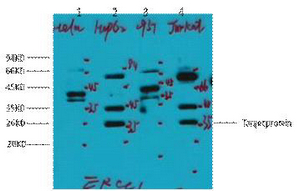SPHK1 (Phospho Ser225) rabbit pAb
- Catalog No.:YP1683
- Applications:WB
- Reactivity:Human;Mouse;Rat
- Target:
- SPHK1
- Fields:
- >>Sphingolipid metabolism;>>Metabolic pathways;>>Calcium signaling pathway;>>Sphingolipid signaling pathway;>>Phospholipase D signaling pathway;>>VEGF signaling pathway;>>Apelin signaling pathway;>>Fc gamma R-mediated phagocytosis;>>Tuberculosis
- Gene Name:
- SPHK1 SPHK SPK
- Protein Name:
- SPHK1 (Phospho-Ser225)
- Human Gene Id:
- 8877
- Human Swiss Prot No:
- Q9NYA1
- Mouse Gene Id:
- 20698
- Mouse Swiss Prot No:
- Q8CI15
- Rat Gene Id:
- 170897
- Rat Swiss Prot No:
- Q91V26
- Immunogen:
- Synthesized peptide derived from human SPHK1 (Phospho-Ser225)
- Specificity:
- This antibody detects endogenous levels of SPHK1 (Phospho-Ser225) at Human, Mouse,Rat
- Formulation:
- Liquid in PBS containing 50% glycerol, 0.5% BSA and 0.02% sodium azide.
- Source:
- Polyclonal, Rabbit,IgG
- Dilution:
- WB 1:500-2000
- Purification:
- The antibody was affinity-purified from rabbit serum by affinity-chromatography using specific immunogen.
- Concentration:
- 1 mg/ml
- Storage Stability:
- -15°C to -25°C/1 year(Do not lower than -25°C)
- Other Name:
- Sphingosine kinase 1 (SK 1) (SPK 1) (EC 2.7.1.91)
- Observed Band(KD):
- 42kD
- Background:
- The protein encoded by this gene catalyzes the phosphorylation of sphingosine to form sphingosine-1-phosphate (S1P), a lipid mediator with both intra- and extracellular functions. Intracellularly, S1P regulates proliferation and survival, and extracellularly, it is a ligand for cell surface G protein-coupled receptors. This protein, and its product S1P, play a key role in TNF-alpha signaling and the NF-kappa-B activation pathway important in inflammatory, antiapoptotic, and immune processes. Alternatively spliced transcript variants encoding different isoforms have been found for this gene. [provided by RefSeq, Sep 2011],
- Function:
- catalytic activity:ATP + sphinganine = ADP + sphinganine 1-phosphate.,catalytic activity:ATP + sphingosine = ADP + sphingosine 1-phosphate.,cofactor:Magnesium.,function:Catalyzes the phosphorylation of sphingosine to form sphingosine 1-phosphate (SPP), a lipid mediator with both intra-and extracellular functions. Also acts on D-erythro-sphingosine and to a lesser extent sphinganine, but not other lipids, such as D,L-threo-dihydrosphingosine, N,N-dimethylsphingosine, diacylglycerol, ceramide, or phosphatidylinositol.,similarity:Contains 1 DAGKc domain.,subunit:Interacts with ACY1 (By similarity). Binds to calmodulin. Interacts with SPHKAP.,tissue specificity:Widely expressed with highest levels in adult liver, kidney, heart and skeletal muscle.,
- Subcellular Location:
- Cytoplasm . Nucleus . Cell membrane . Endosome membrane ; Peripheral membrane protein . Membrane, clathrin-coated pit . Cell junction, synapse . Translocated from the cytoplasm to the plasma membrane in a CIB1-dependent manner (PubMed:19854831). Binds to membranes containing negatively charged lipids but not neutral lipids (PubMed:24929359). Recruited to endocytic membranes by sphingosine where promotes membrane fusion (By similarity). .
- Expression:
- Widely expressed with highest levels in adult liver, kidney, heart and skeletal muscle. Expressed in brain cortex (at protein level) (PubMed:29662056).
- June 19-2018
- WESTERN IMMUNOBLOTTING PROTOCOL
- June 19-2018
- IMMUNOHISTOCHEMISTRY-PARAFFIN PROTOCOL
- June 19-2018
- IMMUNOFLUORESCENCE PROTOCOL
- September 08-2020
- FLOW-CYTOMEYRT-PROTOCOL
- May 20-2022
- Cell-Based ELISA│解您多样本WB检测之困扰
- July 13-2018
- CELL-BASED-ELISA-PROTOCOL-FOR-ACETYL-PROTEIN
- July 13-2018
- CELL-BASED-ELISA-PROTOCOL-FOR-PHOSPHO-PROTEIN
- July 13-2018
- Antibody-FAQs
- Products Images

- Western Blot analysis of 1 MCF-7 cell, 2 LPS 100ng/mL 30min treated ,using primary antibody at 1:1000 dilution. Secondary antibody(catalog#:RS23920) was diluted at 1:10000



